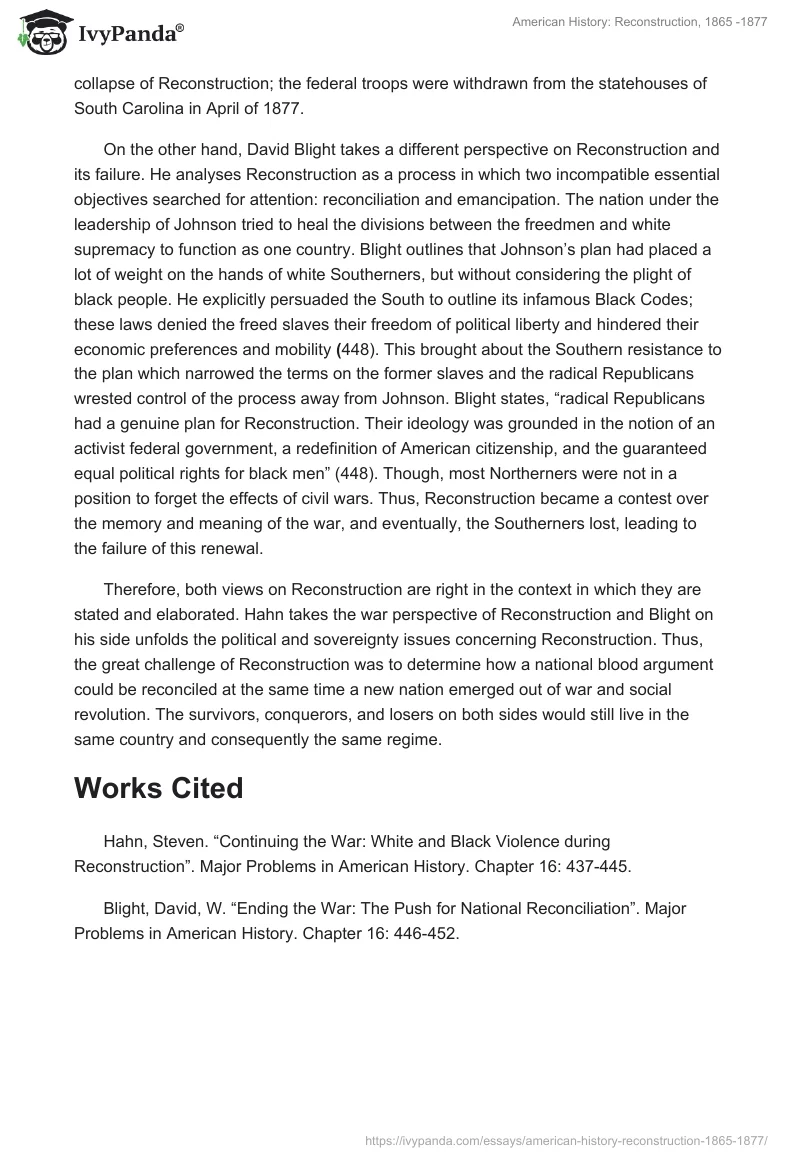The Reconstruction that took place within the year 1865 – 1877 was deemed to reduce civil war and enforce laws that govern human rights and self-governance especially in South America. This was because of the differences between the South American people who were mostly slaves and the white supremacy. Shifting the immense number of South people to their ancestral land was impossible, or if they could have been, it would have resulted in their lapse into barbarism. And thus there was a need for Reconstruction to contain the inferior race. However, the plan for Reconstruction failed and it had enormous costs for the African American population of the South. Its failure also postponed the socio-economic recovery of the entire region until the twentieth century. Historians have argued on the meaning of Reconstruction and more importantly, the reasons for its failure. Therefore, this paper analyses the different views of two historians; Steven Hahn and David Blight, on the reasons for Reconstruction’s abandonment.
Steven Hahn elaborates that former freedmen and Confederates were both prepared to initialize an armed defense of their expectations. This was depicted by the formation of associations such as the Union League, in which the league councils constituted themselves as vehicles not only of Republican electoral mobilization, but also of community development, defense, and self-determination. The defense was reflecting an extensive tradition of Southern violence that had previously undergirded slavery. Among the various activities that Union League councils across the South pursued in 1867, few commanded more immediate attention than those required to implement the provisions and goals of the Reconstruction Acts (Hahn, 339).
This shows that Reconstruction was deemed to fail. Hahn urges that Reconstruction was abandoned when freed slaves lost the military support of the North, which had exhausted within 1861 – 1877; the author notes that “Arkansas Powell first tried to borrow guns from various northern states and then when it failed, sent an emissary to New York to purchase rifles and ammunition. Unfortunately, a contingent of well-prepared Klansmen intercepted the shipment” (441). Unfortunately, the military rejected the popular will of the South, hence the freedmen were outgunned leading to the collapse of Reconstruction; the federal troops were withdrawn from the statehouses of South Carolina in April of 1877.
On the other hand, David Blight takes a different perspective on Reconstruction and its failure. He analyses Reconstruction as a process in which two incompatible essential objectives searched for attention: reconciliation and emancipation. The nation under the leadership of Johnson tried to heal the divisions between the freedmen and white supremacy to function as one country. Blight outlines that Johnson’s plan had placed a lot of weight on the hands of white Southerners, but without considering the plight of black people. He explicitly persuaded the South to outline its infamous Black Codes; these laws denied the freed slaves their freedom of political liberty and hindered their economic preferences and mobility (448). This brought about the Southern resistance to the plan which narrowed the terms on the former slaves and the radical Republicans wrested control of the process away from Johnson. Blight states, “radical Republicans had a genuine plan for Reconstruction. Their ideology was grounded in the notion of an activist federal government, a redefinition of American citizenship, and the guaranteed equal political rights for black men” (448). Though, most Northerners were not in a position to forget the effects of civil wars. Thus, Reconstruction became a contest over the memory and meaning of the war, and eventually, the Southerners lost, leading to the failure of this renewal.
Therefore, both views on Reconstruction are right in the context in which they are stated and elaborated. Hahn takes the war perspective of Reconstruction and Blight on his side unfolds the political and sovereignty issues concerning Reconstruction. Thus, the great challenge of Reconstruction was to determine how a national blood argument could be reconciled at the same time a new nation emerged out of war and social revolution. The survivors, conquerors, and losers on both sides would still live in the same country and consequently the same regime.
Works Cited
Hahn, Steven. “Continuing the War: White and Black Violence during Reconstruction”. Major Problems in American History. Chapter 16: 437-445.
Blight, David, W. “Ending the War: The Push for National Reconciliation”. Major Problems in American History. Chapter 16: 446-452.


